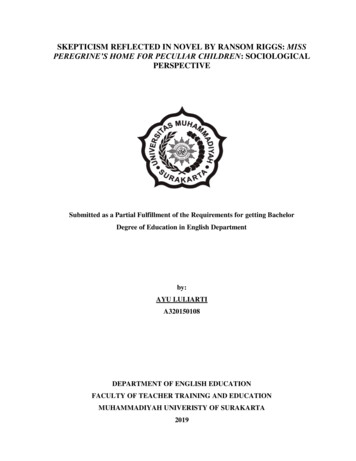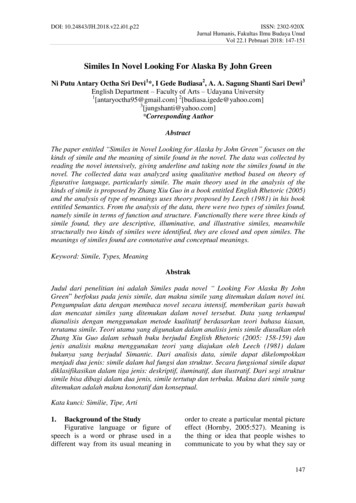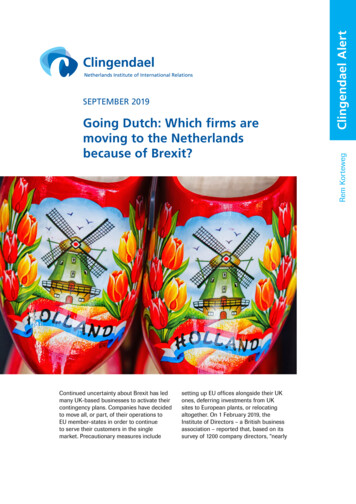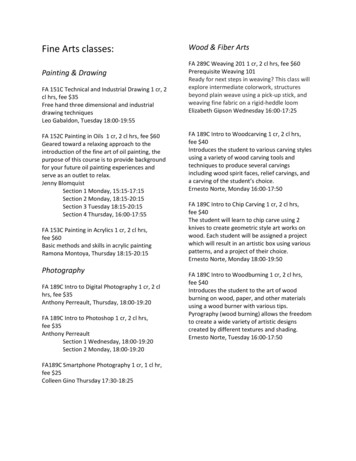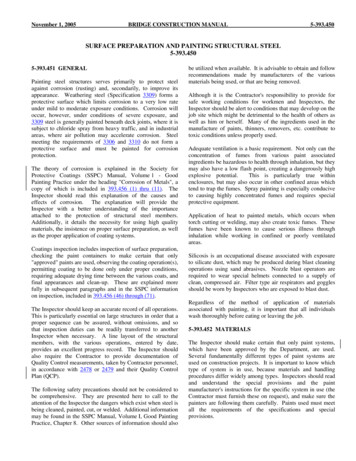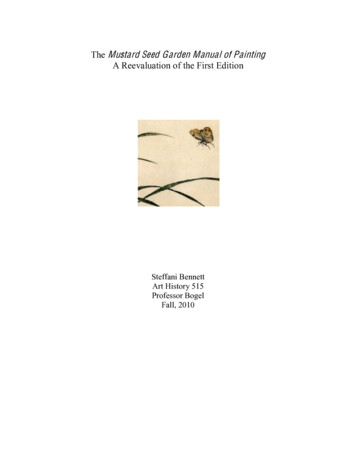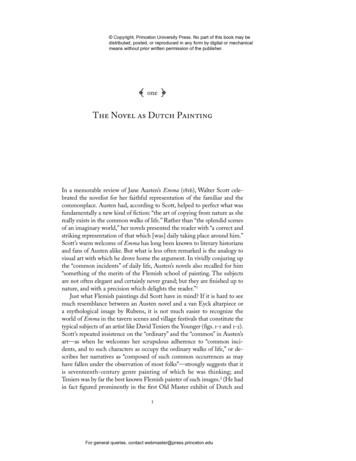
Transcription
Copyright, Princeton University Press. No part of this book may bedistributed, posted, or reproduced in any form by digital or mechanicalmeans without prior written permission of the publisher. one The Novel as Dutch PaintingIn a memorable review of Jane Austen’s Emma (1816), Walter Scott cele brated the novelist for her faithful representation of the familiar and thecommonplace. Austen had, according to Scott, helped to perfect what wasfundamentally a new kind of fiction: “the art of copying from nature as shereally exists in the common walks of life.” Rather than “the splendid scenesof an imaginary world,” her novels presented the reader with “a correct andstriking representation of that which [was] daily taking place around him.”Scott’s warm welcome of Emma has long been known to literary historiansand fans of Austen alike. But what is less often remarked is the analogy tovisual art with which he drove home the argument. In vividly conjuring upthe “common incidents” of daily life, Austen’s novels also recalled for him“something of the merits of the Flemish school of painting. The subjectsare not often elegant and certainly never grand; but they are finished up tonature, and with a precision which delights the reader.”1Just what Flemish paintings did Scott have in mind? If it is hard to seemuch resemblance between an Austen novel and a van Eyck altarpiece ora mythological image by Rubens, it is not much easier to recognize theworld of Emma in the tavern scenes and village festivals that constitute thetypical subjects of an artist like David Teniers the Younger (figs. 1-1 and 1-2).Scott’s repeated insistence on the “ordinary” and the “common” in Austen’sart—as when he welcomes her scrupulous adherence to “common inci dents, and to such characters as occupy the ordinary walks of life,” or de scribes her narratives as “composed of such common occurrences as mayhave fallen under the observation of most folks”—strongly suggests that itis seventeenth-century genre painting of which he was thinking; andTeniers was by far the best known Flemish painter of such images.2 (He hadin fact figured prominently in the first Old Master exhibit of Dutch and1For general queries, contact webmaster@press.princeton.edu
Copyright, Princeton University Press. No part of this book may bedistributed, posted, or reproduced in any form by digital or mechanicalmeans without prior written permission of the publisher.2chapter oneFigure 1-1. David Teniers the Younger: Tavern Scene, 1658. National Gallery ofArt, Washington, D.C. Gift of Robert H. and Clarice Smith. Image 2006Board of Trustees, National Gallery of Art, Washington, D.C.Flemish painting sponsored by the British Institution in London the pre vious year.)3 But nineteenth-century writers did not often distinguishclosely between the Dutch and the Flemish in this connection; and Scott’sallusion to “the Flemish school” serves less to evoke individual pictures oreven artists than to conjure up Netherlandish genre as a whole. Like“Dutch painting” or “the Dutch school”—phrases that recur with evenmore frequency in the criticism of the period—it is shorthand for a type ofpainting that itself, as we shall see, is a painting of types. That such phrasessimultaneously evoke ideas of the generic or the typical and of the meticu lously detailed and particular (what Scott here calls “precision”) is a seem ing contradiction that goes to the very heart of the ambivalence that Dutchpainting, whether on canvas or in words, could inspire.4Scott’s comparison of Austen’s art to that of Flanders was not the firstanalogy between the novel and Netherlandish painting; and it was certainlynot the last.5 At least as early as 1804, Anna Barbauld had already used theanalogy to characterize the painstaking detail of Samuel Richardson: theauthor of Pamela and Clarissa, in her words, had “the accuracy and finish ofa Dutch painter . . . content to produce effects by the patient labour ofFor general queries, contact webmaster@press.princeton.edu
Copyright, Princeton University Press. No part of this book may bedistributed, posted, or reproduced in any form by digital or mechanicalmeans without prior written permission of the publisher.the novel as dutch painting3Figure 1-2. David Teniers the Younger: Village Festival with Aristocratic Couple,1652. Musée du Louvre, Paris. Photo Credit: Erich Lessing/Art Resource, N.Y.minuteness”—a phrase that Leslie Stephen echoed almost exactly when hein turn evoked the novelist’s “Dutch painting of extraordinary minuteness”in an essay in the Cornhill more than half a century later.6 ReviewingNorthanger Abbey and Persuasion in 1821, Richard Whately repeated Scott’scomparison of Austen’s fiction to Flemish painting and added an allusionto the “Dutch school” as well.7 In 1859, George Henry Lewes returned tothe Flemish analogy in an essay that sought to defend Austen’s art from thestrictures of Charlotte Brontë—an essay that also seized the occasion, notcoincidentally, to contend that Austen’s “sympathy with ordinary life” hadmuch in common with that of the recently published Scenes of Clerical Lifeby George Eliot.8 As we shall see, the latter’s own defense of her art byanalogy to Dutch painting in Adam Bede that same year predictably en couraged many of her critics to pursue the comparison in the decades thatfollowed. Yet Anthony Trollope was also compared to a Dutch painter, andso too were Harriet Martineau, Elizabeth Gaskell, and MargaretOliphant—whose Chronicles of Carlingford were implicitly chided for theiraffinity with that “apostle of the Dutch school, Mr. Thackeray.”9 EvenThackeray’s most celebrated rival was assimilated to the “school”: while onereviewer confined himself to a single scene, calling the banquet at Todgers’For general queries, contact webmaster@press.princeton.edu
Copyright, Princeton University Press. No part of this book may bedistributed, posted, or reproduced in any form by digital or mechanicalmeans without prior written permission of the publisher.4chapter onein Martin Chuzzlewit (1844) a “notable . . . piece of Dutch painting,”Charles Kingsley’s impatient allusion in Alton Locke (1850) to “these days ofDutch painting and Boz” managed to make Dickens and the Dutch virtu ally synonymous, before he in turn grudgingly set out to satisfy the pre sumed appetite for such art with a detailed description of an “old eccentric’sabode.”10Having evoked “the merits of the Flemish school” rather warmly in hisreview of Emma, Scott himself returned to the analogy more than a decadelater—only now it was Daniel Defoe whose fictions were more equivocallypraised for the resemblance:The air of writing with all the plausibility of truth must, in almostevery case, have its own peculiar value; as we admire the paintings ofsome Flemish artists, where, though the subjects drawn are meanand disagreeable, and such as in nature we would not wish to studyor look close upon, yet the skill with which they are represented bythe painter gives an interest to the imitation upon canvass which theoriginal entirely wants. But, on the other hand, when the power ofexact and circumstantial delineation is applied to objects which weare anxiously desirous to see in their proper shape and colours, wehave a double source of pleasure, both in the art of the painter, andin the interest which we take in the subject represented. Thus thestyle of probability with which De Foe invested his narratives, wasperhaps ill bestowed, or rather wasted, upon some of the workswhich he thought proper to produce.11There is no ambiguity here about the kind of low genre painting Scott hasin mind. Defoe’s rogues and criminals would certainly seem more at homein a tavern by Teniers than would an Emma or a Mr. Knightley (see fig. 1-1).The allusion to “mean and disagreeable” subjects nonetheless helps to illu minate the faint condescension with which Scott had earlier praised Austen’s“Flemish” art for confining itself to “the middling classes of society”—while “those which are sketched with most originality and precision, belongto a class rather below that standard.”12 His class discriminations are care fully calibrated, but in both cases Flemish painting evokes the representa tion of the lower orders as well as the circumstantial details of the novelists’style.Despite Scott’s well-known distinction between his own “Big Bow wowstrain” and “the exquisite touch” with which Austen rendered “ordinarycommon-place things and characters,”13 one French authority identifiedthe author of Waverley too with the tradition of Netherlandish paintingFor general queries, contact webmaster@press.princeton.edu
Copyright, Princeton University Press. No part of this book may bedistributed, posted, or reproduced in any form by digital or mechanicalmeans without prior written permission of the publisher.the novel as dutch painting5in fiction. According to Hippolyte Taine in his Histoire de la littératureanglaise (1863), Scott was “like a painter who, having finished with greatceremonial paintings, finds an interest and a beauty in the bourgeois housesof some provincial dump, or in a farm framed by beds of beetroots andturnips”—a painter of “interior and genre pictures, so local and minute, andwhich, like those of the Flemish, indicate the rise of a bourgeoisie.” ForTaine, Scott’s true contribution was not the imaginative reconstruction ofhistory but the representation of “the real and modern world,” a represen tation that had profoundly influenced—and by no means all to the good—a “whole literature” that followed:Miss Austen, Miss Brontë, Mrs. Gaskell, George Eliot, Bulwer,Thackeray, Dickens, and so many others paint especially or entirely,as he does, contemporary life as it is, without embellishment, at allranks, often amongst the people, even more often amongst the mid dle class. And the same causes which made the historical novel byhim and others come to nothing made the novel of manners by theseauthors succeed. They were too minute copyists and too decidedmoralists, incapable of the great divinations and the wide sympa thies which open up history; their imagination was too literal, andtheir judgment too fixed. It is precisely with these faculties that theycreated a new species of novel, which proliferates today in thousandsof offshoots, with such abundance that talents in this branch of lit erature may be counted by hundreds, and that one can only comparefor original and national vigor to the great age of Dutch painting.14Great as it may be, the “great age of Dutch painting” is clearly a doubtfulprecursor for the new age of the novel.I shall return to the implications of Taine’s mixed assessment through out this book. But it is worth noting here that the very numbers in whichthis “new species” proliferates is one source of the critic’s unease—as well asa reason for the analogy to a visual tradition famous for the very abundanceof the images it produced. If Dutch painting constituted the “first massconsumers’ art market” in Europe, as Simon Schama contends, then thenineteenth-century novel was surely the second; and the popularity of bothforms raised continual questions about canons of taste and hierarchies ofvalue.15 Indeed, Taine may be writing at the moment only about Englishliterature, but he is quite clear that Dutch painting in fiction is not confinedto England. “Ask a cook which picture she prefers in the museum,” he ob serves caustically, “and she will show you a kitchen, in which the saucepansare so well done that one is tempted to dip into the soup.” Such cooks—orFor general queries, contact webmaster@press.princeton.edu
Copyright, Princeton University Press. No part of this book may bedistributed, posted, or reproduced in any form by digital or mechanicalmeans without prior written permission of the publisher.6chapter onerather, the readers for whom they stand—are now apparently everywhere inEurope: “this inclination . . . is now European,” and the novel which re sponds to such taste is a European phenomenon. (Where the English dif fer, Taine suggests, is their impulse to moralize the picture.)16Though I shall argue that there were in fact particular reasons to con nect English fiction to Dutch painting, Taine was not alone in finding suchpainting everywhere in the novel. He does not add any Continental namesto the litany of “Miss Austen, Miss Brontë,” and the rest, but many readersthought that Balzac especially belonged in their company. In a study ofNetherlandish art published six years later, Taine himself would compareRembrandt to Balzac; but by the time that he thus reversed the direction ofthe analogy (Rembrandt was “comme notre Balzac”), the comparison of theFrench novelist to Dutch and Flemish painters had become commonplaceon both sides of the Channel.17 In fact Balzac’s realist novels had scarcelybegun to appear in the 1830s before critics drew on the analogy to note theextraordinary detail with which his people and places were evoked. At leastas early as 1833, the Revue des deux mondes suggested that an old woman inLe médecin de campagne might have had “her wrinkles counted by the brushof Gerrit Dou,” and allusions to Dou, Teniers, Rembrandt, and others reg ularly recurred in the decades that followed. In France one reviewer char acterized Père Goriot (1834) as a “tableau flamand,” and another invoked the“pinceau flamand” of César Birotteau (1837);18 in England Eugénie Grandet(1833) was “a Dutch picture of an interior”—this in a review that otherwiseexcoriated the novelist—while Balzac himself was “a painter of the Flem ish school” or a “Dutch painter in prose.”19 As the number of volumes inthe Comédie humaine multiplied, Balzac’s fiction became a whole gallery ofNetherlandish art:We have all passed entire hours in the galleries of the Louvre in con templating some of those marvelous interiors by van Ostade, Metsu,or Gerrit Dou, into which our imagination enters, takes up resi dence, and amuses itself; M. de Balzac sometimes knows how to giveto his novels the kind of mysterious attraction these pictures present. . . The world that M. de Balzac has the gift of understanding andreproducing is the same as that of these bourgeois painters.20Balzac was not the only Continental writer to be identified—whetherfor good or ill—with such pictures. In 1861, for example, Flaubert was at tacked for creating a world that resembled “a Flemish or Dutch museum,”and the analogy was used for other realists, some German as well as French,throughout the century.21 But the sheer fecundity of Balzac’s art—both theFor general queries, contact webmaster@press.princeton.edu
Copyright, Princeton University Press. No part of this book may bedistributed, posted, or reproduced in any form by digital or mechanicalmeans without prior written permission of the publisher.the novel as dutch painting7astonishing rate at which the novels appeared and the descriptive abun dance of his style—made him an especially salient figure for a kind of artthat was itself strongly associated with the proliferation of detail. “Whereanother writer makes an allusion,” as Henry James memorably put it,“Balzac gives you a Dutch picture.” That so much of Balzac’s descriptiveenergy was directed toward the representation of houses and theirinteriors—what James called his “passion for bric-à-brac”—intensified hisassociation with the domestic realism of so much Netherlandish painting.22Indeed, it is very much to the point that the use of the word “réalisme” inan aesthetic sense seems to have first come into circulation with an 1846study of Dutch and Flemish art,23 and that its earliest migration into En glish seems to have been an anonymous essay on Balzac in the WestminsterReview of 1853—an essay that partly sought to counter “the well-knowncomparison of Balzac to the Dutch painters.” (The comparison was fairenough, the critic conceded, “as regards the truthfulness with which he hasdepicted interiors, and the habits of some homely characters,” but it failedto do justice to other aspects of his art—including “his exquisite femalecharacters.”)24That the nineteenth century saw Dutch painting virtually everywherein the novel may suggest that the analogy was used rather loosely, but italso testifies, as I shall argue, that fundamental characteristics of the genreitself were at stake: in associating narrative fiction with the visual art of theseventeenth-century Netherlands, nineteenth-century commentators wereboth registering and uneasily displacing many of those elements that wehave come to identify, after Ian Watt, with the “formal realism” of thenovel.25 Although literary historians sometimes write as if the novel werethe first genre in which such realism dominates an entire work (as opposedto figuring in the margins, like servants in Greek tragedy or peasantsscrupulously depicted on the borders of a medieval manuscript),26 many ofthe images produced by seventeenth-century Netherlandish paintersclearly provided an important precedent; and however vaguely they con jured with the analogy, nineteenth-century writers were well aware of thefact. The detailed rendering of material particulars, the representation of“ordinary” people and events rather than heroic and mythical ones, theclose attention to the rituals and habits of daily life, especially the domesticlife of the middle classes: all these familiar characteristics of novelisticrealism had their visual analogues in the so-called Golden Age of Dutchpainting—the approximately hundred years, from 1580 to 1680, in whichartists had produced the numerous images that continued to circulatethrough Europe in the centuries that followed.For general queries, contact webmaster@press.princeton.edu
Copyright, Princeton University Press. No part of this book may bedistributed, posted, or reproduced in any form by digital or mechanicalmeans without prior written permission of the publisher.8chapter oneThe productivity of those years was truly extraordinary: by some recentestimates, over five million works were painted in seventeenth-centuryHolland.27 While many of these did not survive, others not only survivedbut multiplied. Both in eighteenth-century France, where the vogue forDutch and Flemish painting first established itself among the great aristo cratic collectors as well as the heterogeneous crowds who frequented theParisian city fairs, and in late eighteenth- and early nineteenth-centuryBritain, where many of the works from the French collections migrated inthe aftermath of the Revolution and the Napoleonic Wars, the taste forNetherlandish art had been further popularized by influential collections ofengravings like Jean Baptiste Pierre Lebrun’s three-volume Galerie despeintres flamands, hollandais et allemands (1792–96), or John Smith’s ninevolume Catalogue Raisonnée of the Works of the Most Eminent Dutch, Flemishand French Painters (1829–42)—not to mention the less costly reproductionof individual prints.28 The very abundance of images that would promptanxious analogies to the contemporary proliferation of the novel also meantthat nineteenth-century writers could expect their readers to have somesense of what allusions to such art signified. Before there was “realism” in aliterary sense there was Dutch painting, both as a phenomenon and as aparadigm for criticism.29This is not to say that “Dutch painting” (or Flemish, for that matter)always signified the same thing. Like most critical terms, including suchnotoriously vexed examples as “realism” or “the novel,” it named a set offamily resemblances rather than a clearly defined essence—a set of overlap ping and related characteristics, not all of which were necessarily invokedin any single use of the phrase. At the risk of overschematizing, let mespell out the range of lexical definitions that could be in play whenever anineteenth-century writer compared a novel or an excerpt from a novel toDutch painting:Dutch painting. 1) the precise transcription of detail, especially ofmaterial surfaces, such as those of furniture or dress; more generally,the copying of such appearances. 2) an abundance of such detail,sometimes at the expense of a governing intellectual or spiritualorder; by extension, an excess of the trivial. 3) an attention to tran sient matters of costume or custom; the recording of the historicallyspecific and local rather than the general or universal. 4a) the repre sentation of ordinary or common subjects, both in the class of theFor general queries, contact webmaster@press.princeton.edu
Copyright, Princeton University Press. No part of this book may bedistributed, posted, or reproduced in any form by digital or mechanicalmeans without prior written permission of the publisher.the novel as dutch painting9persons depicted and in the familiarity of their activities; typicalrather than exceptional persons or events; b) more specifically, therepresentation of the home, especially of domestic interiors and ofwomen engaged in household activities. 5) the representation of lowor vulgar subjects both as to the class of persons depicted and as tothe nature of their activities: smoking, eating, drinking, etc. 6) inconnection with landscape, the representation of the cultivated,tamed or domesticated; or of the literally or metaphorically flat. Seealso Dutch art, the Dutch school, Flemish painting, etc.Yet even as this brief taxonomy may help to clarify some of what wasmeant when nineteenth-century writers reached for the analogy, it threat ens to obscure the way in which such definitions overlap and entail oneanother, so that to make the allusion was to call up a whole set of connota tions at once. Thus whether or not “mean and disagreeable” subjects, inScott’s phrase, were overtly at issue, to compare a novel to Dutch paintingwas almost invariably to associate it with the comparatively low andhumble—a long intellectual tradition, as we shall see, having identified the“lowness” of such painting not just with the order of people depicted butwith its very attention to matter itself. So too the feminized subjects ofmany Dutch and Flemish paintings meant that an aura of domesticity andfemininity (and their implied limitations) often hovered around the para digm in nineteenth-century criticism—as in Elizabeth Barrett Browning’sdismissive allusion to Jane Austen as a “Dutch painter” of English “middlelife,” whose “ladyhood ” was “stronger in her than her humanity.”30 As if tothink of Dutch painting were automatically to conjure up images of womenin the kitchen, the same critic who associated the Chronicles of Carlingfordwith the “Dutch school” also scolded Oliphant for attending too much tothe housekeeping side of novel writing: “the artist’s concern is like Mary’s,with the spiritual guest, not like Martha’s, with the platters and householdserving.”31 The small scale of so many Dutch paintings, whose size was de termined by the fact that they were designed for private households ratherthan public spaces, and the meticulous detail for which Northern art wasfamous, especially that of the so-called fijnschilders (literally, fine painters)like Gerrit Dou and Frans van Mieris the Elder (figs. 1-3 and 1-4), couldeasily reinforce nineteenth-century associations of the feminine with thedetailed and the trivial—and of all three with certain tendencies in thenovel.32 Writing of the early George Eliot, for example, the youthful HenryJames characterized her “observation” as “decidedly of the feminine kind: itdeals, in preference, with small things”—this in a review that began byFor general queries, contact webmaster@press.princeton.edu
Copyright, Princeton University Press. No part of this book may bedistributed, posted, or reproduced in any form by digital or mechanicalmeans without prior written permission of the publisher.10chapter oneLeft: Figure 1-3. Gerrit Dou: Girl Chopping Onions, 1646. Royal Collection,London. The Royal Collection 2006 Her Majesty Queen Elizabeth IIRight: Figure 1-4. Frans van Mieris the Elder: A Woman in a Red Jacket Feeding aParrot, c. 1663. National Gallery, London. The National Gallery, Londonquoting the novelist’s own defense of her art on the model of Dutch paint ing and that followed with praise for her scenes of “low life” after “theDutch masters whom she emulates.”33 In a related vein, Leslie Stephenelaborated at length on how “the feminine element in Richardson’s character”manifested itself in that “interest in small details, which only women ex hibit in perfection,” before announcing that “the result of all this is a sort ofDutch painting of extraordinary minuteness.”34Of course, novels are not paintings, though they may aspire to evoke vi sual images; and while paintings may incorporate words and imply narra tives, they have at most a limited capacity for storytelling. But the perceivedlimitations of painting—especially painting of a certain kind—are verymuch to the point: to the degree to which nineteenth-century viewers sawDutch painting as the “mere” recording of material detail, the apparent stasisand meaninglessness of that detail could be at once attractive and disquiet ing. What Roland Barthes has called the appearance of “an entirely selfsufficient nominalism” in Dutch painting—“an art of the catalogue . . . ofthe concrete itself ”—continually haunts nineteenth-century appropriationsFor general queries, contact webmaster@press.princeton.edu
Copyright, Princeton University Press. No part of this book may bedistributed, posted, or reproduced in any form by digital or mechanicalmeans without prior written permission of the publisher.the novel as dutch painting11of the analogy.35 The ambivalence with which critics approached Balzac’sdescriptive set pieces is a case in point, as they hovered between admirationfor his painterly skill and the sense that an excess of matter threatened notmerely to impede the narrative but to drain it of meaning altogether.“Often when in a story the action is running thin,” as Henry James wittilyremarked, “he stops up your mouth against complaint, as it were, by a chok ing dose of brick and mortar.”36 While Balzac’s defenders praised theverisimilitude of his detail or argued that it served to characterize his peo ple and explain their actions, less sympathetic readers concluded that “hepainted to paint,” in the words of one French critic—that “the mise enscène” had “invaded the idea; the material preoccupation killed the intellec tual synthesis.”37Balzac’s “mighty passion for things,” as James summed it up, made himan easy target for such criticism.38 But the association with Netherlandishpainting, I would argue, often carries something of this charge—even whena novelist’s detail is far less obviously material than is Balzac’s. Austen, forexample, is hardly a visual artist at all: so little does she indulge in physicaldescription of any kind that Scott’s comparison of her to a Flemish paintercan initially seem rather puzzling. Despite the fact that Emma, like Eu génie Grandet after her, begins and ends her narrative in the paternalhousehold, there is nothing in Austen’s novel that resembles the “Dutch”interior in which Balzac sets the history of his provincial heiress. While theopening pages of Balzac’s novel appear to give the reader an exhaustive ac count of the Grandet house in Saumur, from the stone of which it is built(“tufa—a white stone peculiar to the shores of the Loire” and “so soft” thatit is now marked by “numberless irregular holes, whimsically shaped by theinclemency of the climate”) and the precise configuration, materials, andstate of decay of its archway and door, to a thorough inventory of the arti cles of furniture that occupy the large hall where much of the action takesplace—not to mention the appearance of the room’s walls (gray panels withancient moldings) and ceiling (gray beams, whose interstices are filled by amortar which has yellowed with age) or the number of its windows (two)—the reader of Emma knows only that Hartfield is “a comfortable home,”which “in spite of its separate lawn and shrubberies and name,” really be longs to the “large and populous village almost amounting to a town” thatconstitutes Highbury.39 Since “there was scarcely an evening in the week inwhich Emma could not make up a card-table” for her father (E, 17), theWoodhouses apparently possess such an object, but it has nothing likethe substance or location in space of the equivalent piece of furniture atthe Grandets’: “An old cardtable in marquetry, whose upper part formed aFor general queries, contact webmaster@press.princeton.edu
Copyright, Princeton University Press. No part of this book may bedistributed, posted, or reproduced in any form by digital or mechanicalmeans without prior written permission of the publisher.12chapter onechess board, was placed in the area between the two windows. Above thistable was an oval barometer with a black border, ornamented by bands of giltwood, on which the flies had frolicked so licentiously that the gilding wasin question” (CH 3: 1040). Of course Emma does have its share of homelydetails, such as the “minced chicken and scalloped oysters” with which thecompany at the first card party are fed, or the “eight cows, two of themAlderneys” that Harriet Smith enthusiastically recalls from her recent visitto the Abbey-Mill Farm (E, 20, 23). But the “Flemish” precision that Scottregistered is primarily a question of manners and customs, habits of speech,and nuances of character. (Tellingly, in fact, the immediate example he of fers in support of his claim is an extended dialogue—a slightly irritableconversation between Mr. Woodhouse and Isabella on matters rangingfrom the benefits of gruel to the comparative merits of their physicians.)Like Richardson’s “Dutch” minuteness, which for Stephen was exemplifiedin the protracted account of the preparations for the hero’s wedding inGrandison, Austen’s “minuteness of detail”—the phrase is Whately’s—hasrelatively little to do with objects as suc
4 chapter one in Martin Chuzzlewit (1844) a “notable . . . piece of Dutch painting,” Charles Kingsle y’s impatient al lusion in Alton Locke (1850) to “these day s of Dutch painting and Boz” managed to make Dickens and the Dutch virtu ally synonymous,

